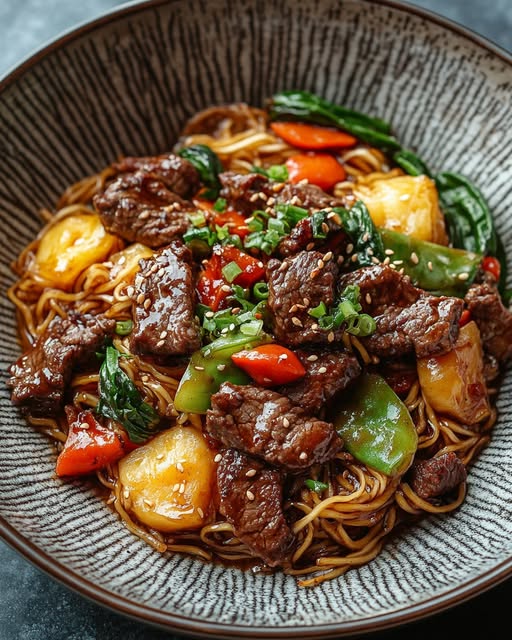Turn Your Kitchen Into a Chinese Restaurant with Beef Stir-Fried Noodles
There’s something magical about the sizzle of a hot wok and the aroma of garlic, ginger, and soy sauce wafting through the air. I remember the first time I tried making Beef Stir-Fried Noodles at home. It was a chilly Sunday evening, and my family was craving something comforting yet exciting. The result? A plate of golden, crispy noodles topped with juicy beef slices and vibrant veggies in a rich, glossy sauce. Everyone loved it so much that it became a regular on our dinner table. Today, I’m sharing this recipe with you—it’s quick, flavorful, and guaranteed to impress!
A Taste of Tradition: The Story Behind Beef Stir-Fried Noodles
This dish is inspired by classic Chinese street food, where vendors whip up steaming plates of stir-fried noodles right before your eyes. Back in the day, these dishes were cooked over roaring flames, giving them that signature smoky flavor known as “wok hei.” While we may not have those same flames in our home kitchens, this recipe brings the essence of those bustling streets to your dining table. Whether you’re new to Asian cooking or a seasoned pro, this version of Beef Stir-Fried Noodles strikes the perfect balance between authenticity and simplicity.
Why You’ll Love This Recipe
First off, this dish is packed with bold flavors—savory, slightly sweet, and umami-rich. The crispy texture of the noodles combined with tender beef and fresh veggies creates a symphony of sensations in every bite. Plus, it’s incredibly versatile. You can tweak the ingredients based on what’s in your pantry or fridge. Best of all, it’s ready in under 30 minutes, making it perfect for busy weeknights or last-minute gatherings.
Perfect Occasions to Make Beef Stir-Fried Noodles
This dish shines on casual weeknights when you need something hearty and satisfying. It’s also a crowd-pleaser for dinner parties or potlucks. Serve it during family game nights or as part of a themed “Chinese Takeout Night” at home. Trust me; your friends will think you ordered takeout from their favorite restaurant!
Ingredients
- 8 oz (225 g) steak of flanks or bavette, thinly sliced against the grain
- 8 oz (225 g) fresh Hong Kong-style stir-fry noodles or thin noodles
- 4 tbsp peanut oil, divided
- 4 heads of bok choy, quartered
- 4 garlic cloves, minced
- 1-inch piece of ginger, finely chopped
- ½ yellow onion, sliced
- ½ carrot, julienned
Marinade for the Meat:
- 2 tbsp Shaoxing wine or dry sherry
- 2 tsp cornstarch
- ¼ tsp salt
Sauce:
- 1 cup low-sodium beef broth
- 2 tbsp soy sauce
- 2 tbsp oyster sauce
- 1 tbsp Shaoxing wine or dry sherry
- 2 tbsp cornstarch
- 1 tsp sugar
- ¼ tsp Chinkiang vinegar
- ¼ tsp white pepper
Substitution Options
If you can’t find Hong Kong-style noodles, swap them with angel hair pasta or ramen noodles. For vegetarians, replace the beef with tofu or mushrooms. Use vegetable broth instead of beef broth if needed. Instead of Shaoxing wine, dry sherry works just fine. And if you don’t have Chinkiang vinegar, a splash of rice vinegar will do the trick.
Preparation Section
Step 1: Marinate the Beef
In a medium bowl, toss the thinly sliced beef with the marinade ingredients. Use your hands to ensure each piece is evenly coated. Let it sit while you prep the rest of the ingredients. Pro tip: Slicing the beef against the grain ensures tenderness. Don’t rush this step—it’s key to locking in flavor!
Step 2: Prepare the Sauce
In another bowl, whisk together the sauce ingredients until the cornstarch dissolves completely. This glossy mixture will thicken beautifully once it hits the heat. Imagine the deep amber color and silky texture—it’s like liquid gold for your noodles!
Step 3: Cook the Noodles
Boil the noodles according to package instructions, then drain and let them dry in a colander. Heat 2 tablespoons of oil in a large nonstick skillet over medium-high heat. Spread the noodles into a flat pancake shape and cook undisturbed until golden brown underneath. Flip and repeat. Transfer the crispy noodles to a serving plate.
Step 4: Cook the Beef
Add 1 tablespoon of oil to the same skillet. Arrange the marinated beef in a single layer and sear for 30 seconds without stirring. Flip and cook the other side until browned but still slightly pink inside. Remove and set aside. Pro tip: Resist the urge to overcrowd the pan—it prevents proper browning.
Step 5: Stir-Fry the Vegetables
Heat the remaining oil in the skillet. Add onions and carrots, stirring quickly to coat. Toss in the garlic and ginger, letting their fragrant aromas bloom for 30 seconds. Then add the bok choy, sautéing until it begins to soften. The vibrant greens and orange carrots look like a rainbow in your pan!
Step 6: Combine Everything
Pour the prepared sauce into the skillet, stirring constantly as it thickens. Return the cooked beef to the pan, mixing everything together. Pour this glorious mixture over the crispy noodles. Chef’s tip: Garnish with sesame seeds or chopped green onions for an extra pop of color and flavor.
Timing
Prep Time: 15 minutes
Cooking Time: 15 minutes
Total Time: 30 minutes
Chef’s Secret
To achieve perfectly crispy noodles, pat them dry after boiling. Excess moisture can make them soggy instead of crunchy. Also, don’t flip the noodle cake too soon—let one side develop a nice golden crust before turning.
Extra Info
Did you know that Shaoxing wine has been used in Chinese cuisine for over 2,000 years? It adds depth and complexity to sauces, making it a must-have ingredient for authentic dishes.
Necessary Equipment
You’ll need a large nonstick skillet or wok, tongs or spatula for flipping, a colander for draining noodles, and bowls for prepping ingredients. A sharp knife and cutting board are essential for slicing beef and chopping veggies.
Storage
To store leftovers, transfer the noodles and toppings separately into airtight containers. Keep them in the fridge for up to two days. Reheat the beef and veggies in a skillet before combining with the noodles to maintain crispiness.
Freezing isn’t ideal for this dish because the noodles lose their crunch. However, you can freeze the uncooked sauce mixture for future use. Simply thaw and reheat when ready to cook.
Avoid microwaving the entire dish together, as the steam will turn the noodles mushy. Instead, reheat components individually for optimal texture.
Tips and Advice
- Use fresh ingredients whenever possible—they make a noticeable difference in flavor.
- Keep your mise en place organized. Having everything prepped and ready speeds up the cooking process.
- Don’t skip the resting time for marinating the beef—it enhances tenderness and flavor absorption.
Presentation Tips
- Serve the dish on a large platter to showcase its vibrant colors.
- Garnish with toasted sesame seeds or chopped scallions for visual appeal.
- Pair with chopsticks for an authentic touch, even if you end up using forks later!
Healthier Alternative Recipes
For lighter versions, try these alternatives:
- Zucchini Noodle Swap: Replace traditional noodles with spiralized zucchini for fewer carbs.
- Leaner Protein: Use chicken breast or turkey strips instead of beef.
- Veggie Boost: Add bell peppers, snap peas, or broccoli florets for extra nutrition.
- Low-Sodium Sauce: Reduce the soy sauce and add more herbs like cilantro or basil.
- Gluten-Free Option: Use tamari instead of soy sauce and gluten-free noodles.
- Oil Reduction:
Cut down on oil by using a nonstick skillet and cooking spray.
Common Mistakes to Avoid
Mistake 1: Overcooking the Pasta
Overcooked noodles become mushy and lack the desired crunch. To avoid this, boil them briefly and pat them dry thoroughly. Test for doneness by tasting—a slight chewiness is ideal.
Mistake 2: Skipping the Marinade Rest
Rushing the marinade step results in less flavorful beef. Always let the meat rest for at least 10 minutes. Pro tip: Cover the bowl with plastic wrap to prevent drying out.
Mistake 3: Crowding the Pan
Cooking too many ingredients at once lowers the pan’s temperature, leading to steaming rather than searing. Work in batches if necessary to achieve proper caramelization.
FAQ
What type of noodles should I use?
Hong Kong-style noodles work best, but substitutes like ramen or angel hair pasta are great too. Just ensure they’re thin and hold up well to frying.
Can I make this dish vegetarian?
Absolutely! Swap beef with tofu or mushrooms and use vegetable broth instead of beef broth. The flavors will still shine.
How do I keep the noodles crispy?
Dry the noodles thoroughly after boiling and avoid adding sauce directly onto them. Serve the sauce and toppings separately if storing leftovers.
Is Shaoxing wine essential?
Yes, it adds unique depth to the dish. If unavailable, substitute with dry sherry or a splash of mirin mixed with rice vinegar.
Can I prep this dish ahead of time?
You can prepare the sauce and chop vegetables a day in advance. However, cook the noodles and beef just before serving for best results.
Why does my sauce taste bland?
Check your seasoning levels. Add a pinch more soy sauce or sugar if needed. Fresh garlic and ginger also boost flavor significantly.
What sides pair well with this dish?
Serve with steamed dumplings, spring rolls, or a simple cucumber salad for a complete meal experience.
Can I double the recipe?
Yes, but increase the size of your skillet or cook in batches to avoid overcrowding.
How do I reheat leftovers?
Reheat the beef and veggies in a skillet, then combine with freshly fried noodles for optimal texture.
Where can I buy Shaoxing wine?
Look for it in Asian grocery stores or online retailers specializing in international foods.
A Final Word
Beef Stir-Fried Noodles is more than just a dish—it’s an experience. From the satisfying crunch of the noodles to the juicy bites of beef and the medley of colorful veggies, it’s a feast for the senses. Whether you’re cooking for yourself or hosting a crowd, this recipe promises deliciousness and joy. So grab your apron, fire up the stove, and let’s bring some Chinese restaurant vibes into your kitchen tonight!

Beef Stir-Fried Noodles
Ingredients
Equipment
Method
- In a medium bowl, toss the thinly sliced beef with the marinade ingredients and let it sit.
- In another bowl, whisk together the sauce ingredients until cornstarch dissolves.
- Boil the noodles according to package instructions, drain them, and let them dry.
- Heat 2 tablespoons of oil in a skillet and cook the noodles until golden brown on both sides. Transfer to a serving plate.
- Add 1 tablespoon of oil to the skillet and sear the marinated beef until browned, then set aside.
- In the same skillet, heat the remaining oil and stir-fry the onions, carrots, garlic, and ginger, then add the bok choy.
- Pour the sauce into the skillet, stirring as it thickens, then add the beef and combine with the crispy noodles.
